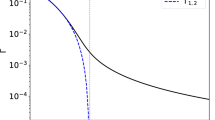Abstract.
The interaction of superluminal radiation with matter in atomic bound-bound and bound-free transitions is investigated. We study transitions in the relativistic hydrogen atom effected by superluminal quanta. The superluminal radiation field is coupled by minimal substitution to the Dirac equation in a Coulomb potential. We quantize the interaction to obtain the transition matrix for induced and spontaneous superluminal radiation in hydrogen-like ions. The tachyonic photoelectric effect is scrutinized, the cross-sections for ground state ionization by transversal and longitudinal tachyons are derived. We examine the relativistic regime, high electronic ejection energies, as well as the first order correction to the non-relativistic cross-sections. In the ultra-relativistic limit, both the longitudinal and transversal cross-sections are peaked at small but noticeably different scattering angles. In the non-relativistic limit, the longitudinal cross-section has two maxima, and its minimum is located at the transversal maximum. Ionization cross-sections can thus be used to discriminate longitudinal radiation from transversal tachyons and photons.
Similar content being viewed by others
References
S. Tanaka, Prog. Theor. Phys. 24, 171 (1960)
Ya.P. Terletsky, Sov. Phys. Dokl. 5, 782 (1961)
O.M.P. Bilaniuk, V.P. Deshpande, E.C. Sudarshan, Am. J. Phys. 30, 718 (1962)
G. Feinberg, Phys. Rev. 159, 1089 (1967)
M.B. Davis, M.N. Kreisler, T. Alväger, Phys. Rev. 183, 1132 (1969)
G. Feinberg, Sci. Am. 222, 69 (1970)
R. Newton, Science 167, 1569 (1970)
F.A.E. Pirani, Phys. Rev. D 1, 3224 (1970)
E. Recami, R. Mignani, Riv. Nuovo Cim. 4, 209 (1974)
E. Recami, Riv. Nuovo Cim. 9, 1 (1986)
E. Recami, F. Fontana, R. Garavaglia, Int. J. Mod. Phys. A 15, 2793 (2000)
M.E. Arons, E.C. Sudarshan, Phys. Rev. 173, 1622 (1968)
J. Dhar, E.C. Sudarshan, Phys. Rev. 174, 1808 (1968)
D.G. Boulware, Phys. Rev. D 1, 2426 (1970)
K. Kamoi, S. Kamefuchi, Prog. Theor. Phys. 45, 1646 (1971)
G. Feinberg, Phys. Rev. D 17, 1651 (1978); G. Feinberg, Phys. Rev. D 19, 3812 (1979)
A. Proca, Compt. Rend. 202, 1366 (1936); A. Proca, Compt. Rend. 202, 1490 (1936); A. Proca, Compt. Rend. 203, 709 (1936)
A. Proca, J. Phys. 7, 347 (1936); J. Phys. 8, 23 (1936)
A.S. Goldhaber, M.M. Nieto, Rev. Mod. Phys. 43, 277 (1971)
R. Tomaschitz, Eur. Phys. J. B 17, 523 (2000)
R.F. Streater, A.S. Wightman, PCT, Spin and Statistics, and All That (Benjamin, New York, 1964)
N.N. Bogolubov, A.A. Logunov, I.T. Todorov, Introduction to Axiomatic Quantum Field Theory (Benjamin, London, 1975)
R. Tomaschitz, Chaos Sol. Fractals 7, 753 (1996)
R. Tomaschitz, Class. Quant. Grav. 18, 4395 (2001)
M. Born, Proc. Roy. Soc. Lond. A 143, 410 (1934)
R. Tomaschitz, Chaos Sol. Fractals 9, 1199 (1998)
V.B. Berestetskii, E.M. Lifshitz, L.P. Pitaevskii, Quantum Electrodynamics (Pergamon, Oxford, 1982)
R. Tomaschitz, Physica A 320, 329 (2003)
R. Tomaschitz, Physica A 307, 375 (2002)
R. Tomaschitz, Physica A 293, 247 (2001)
H.A. Bethe, E.A. Salpeter, Quantum Mechanics of One and Two Electron Atoms (Plenum, New York, 1977)
T.F. Gallagher, Rydberg Atoms (Cambridge Univ. Press, Cambridge, 1994)
V.S. Lebedev, I.L. Beigman, Physics of Highly Excited Atoms and Ions (Springer, New York, 1998)
R. Tomaschitz, Chaos Solitons Fractals 20, 713 (2004)
J.A. Wheeler, R.P. Feynman, Rev. Mod. Phys. 17, 157 (1945)
R. Tomaschitz, Physica A 335, 577 (2004)
Author information
Authors and Affiliations
Corresponding author
Rights and permissions
About this article
Cite this article
Tomaschitz, R. Quantum tachyons. Eur. Phys. J. D 32, 241–255 (2005). https://doi.org/10.1140/epjd/e2004-00185-0
Received:
Published:
Issue Date:
DOI: https://doi.org/10.1140/epjd/e2004-00185-0



